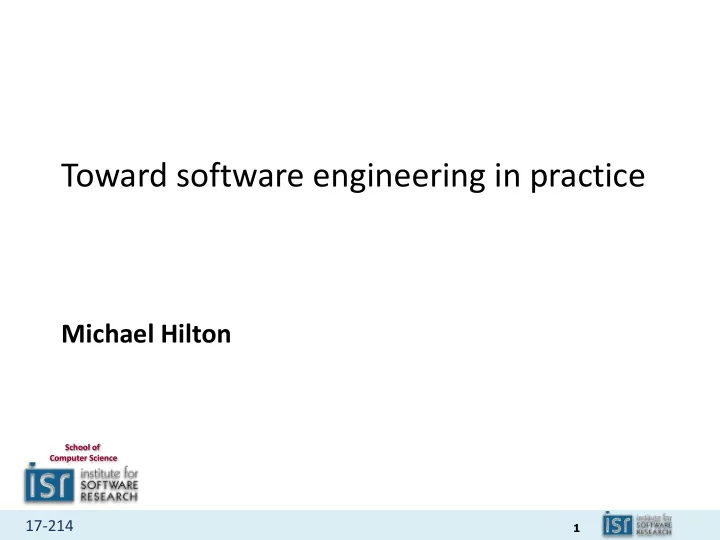

Toward software engineering in practice Michael Hilton School of Computer Science 17-214 1
Learning Goals • Introduction to Software Engineering • Discussion of Test Driven Development 17-214 2
Introduction 17-214 3
SOFTWARE IS EVERYWHERE SOFTWARE IS IMPORTANT 17-214 4
17-214 5
17-214 6
17-214 7
17-214 8
iOS 11 bug 17-214 9
17-214 10
17-214 11
What is engineering? And how is it different from hacking/programming? SOFTWARE ENGINEERING ? 17-214 12
1968 NATO Conference on Software Engineering • Provocative Title • Call for Action • “Software crisis” 17-214 13
“Software Engineering” 17-214 14
Envy of Engineers • Producing a car/bridge – Estimable costs and risks – Expected results – High quality • Separation between plan and production • Simulation before construction • Quality assurance through measurement • Potential for automation 17-214 15
Software Engineering? ‘‘The Establishment and use of sound engineering principles in order to obtain economically software that is reliable and works efficiently on real machines.” [Bauer 1975, S. 524] 17-214 16
17-214 17
What happened with HealthCare.gov? • Poor team and process coordination. • Changing requirements. • Inadequate quality assurance infrastructure. • Architecture unsuited to the ultimate system load. 17-214 18
PROCESS 17-214 19
How to develop software? 1. Discuss the software that needs to be written 2. Write some code 3. Test the code to identify the defects 4. Debug to find causes of defects 5. Fix the defects 6. If not done, return to step 1 17-214 20
Example process issues Change Control: Mid-project informal agreement to changes • suggested by customer or manager. Project scope expands 25-50% Quality Assurance: Late detection of requirements and design • issues. Test-debug-reimplement cycle limits development of new features. Release with known defects. Defect Tracking: Bug reports collected informally, forgotten • System Integration: Integration of independently developed • components at the very end of the project. Interfaces out of sync. Source Code Control: Accidentally overwritten changes, lost work. • Scheduling: When project is behind, developers are asked weekly • for new estimates. 17-214 21
TEST DRIVEN DEVELOPMENT (TDD) 17-214 22
Three simple rules 1. You are not allowed to write any production code unless it is to make a failing unit test pass . 2. You are not allowed to write any more of a unit test than is sufficient to fail ; and compilation failures are failures. 3. You are not allowed to write any more production code than is sufficient to pass the one failing unit test. 17-214 23
TDD Cycle 17-214 24
Why TDD? “The act of writing a unit test is more an act of design than of verification. It is also more an act of documentation than of verification. The act of writing a unit test closes a remarkable number of feedback loops, the least of which is the one pertaining to verification of function”. 17-214 25
Advantages of TDD • Clear place to start • Much less code thrown away, less wasted effort • Less Fear • Side Effect: Robust test suite 17-214 26
A programming exercise that you repeat many many times, looking to make small, incremental improvements. CODE KATA 17-214 27
Diamond Kata • Given a letter, print a diamond starting with ‘A’ with the supplied letter at the widest point. • For example: ‘C’ prints A B B C C B B A 17-214 28
TDD Demo 17-214 29
IMPRESSIONS? 17-214 30
TDD Research • Hilton et al.: Students learn better when forced to write tests first • Bhat et al.: At Microsoft, projects using TDD had greater than two times code quality, but 15% more upfront setup time • George et al.: TDD passed 18% more test cases, but took 16% more time • Scanniello et al.: Perceptions of TDD include: novices believe TDD improves productivity at the expense of internal quality 17-214 31
More TDD Research • Fucci et al.: Results: The Kruskal-Wallis tests did not show any significant difference between TDD and TLD in terms of testing effort (p-value = .27), external code quality (p-value = .82), and developers' productivity (p-value = .83). • Fucci et al.: Conclusion: The claimed benefits of TDD may not be due to its distinctive test-first dynamic, but rather due to the fact that TDD-like processes encourage fine-grained, steady steps that improve focus and flow. 17-214 32
WHY IS THIS HARD? 17-214 33
Summary: take 17-313 this fall! • Software Engineering in practice requires consideration of numerous issues--- technical and social---above the level of individual class design/implementation. • Do you think this is interesting? 17-313, Foundations of Software Engineering is offered in the Fall. • And consider the undergraduate SE minor! 17-214 34
Recommend
More recommend